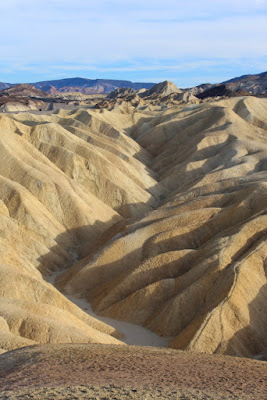Due to COVID-19 the Furnace Creek Visitor Center was closed, but the Park Service had an outside window that was open to collect entrance fees. Fortunately, I had a Golden Age Passport!
For centuries humans have use Borax (also known as sodium borate) in detergents, cleaning products, water-softening, cosmetics, anti-fungal compounds, fire retardants, metallurgy, texturing agents, insecticides, and many other uses. Located just north of the Visitor Center is the Old Harmony Borax Works display and a one-way trail that winds through Mustard Canyon.
A Historic Market states:
On the Marsh near this point Borax was discovered in 1881 by Aaron Winters who later sold his holdings to W.T. Coleman of San Francisco in 1882. Coleman built the Harmony Borax Works and commissioned his superintendent J.W.S. Perry to design wagons and locate a suitable route to Mojave. The work of gathering the ore (called "Cottonball") was done by Chinese workmen. From this point processed Borax was transported 165 miles by twenty mule team to the railroad until 1889.
 |
| Photographer Unknown |
 |
| Photographer Unknown |
 |
| Photographer Unknown |
Mustered Canyon gets its name from the mustered colored rock and dirt that is a yellow-green color. Along the trail through Mustard Canyon there are several adobe building ruins that were used when Borax was being mined at the site. It is interesting to note that the soil in this area does not support any type of plant life.
The historic Inn at Death Valley (formerly called Furnace Creek Inn) was originally built in 1927 by the Pacific Coast Borax Company and contained twelve rooms. Over the years the Inn has been expanded and upgraded and is now open from October through May. The property is listed as a member of Historic Hotels of America.
Zabriskie Point is the most photographed area in Death Valley and a favorite place to visit at sunrise and sunset. Several hiking trails leave from the parking lot and one paved trail that leads to the top of a colorful mound is handicap accessible.
Just east of Zabriskie Point is the one-way Twenty Mule Team Canyon trail that has some spectacular scenery as it winds around and between some of picturesque formations.
Dantes Point, at an elevation of 5,475 feet, is one of the best places to get an overall view of Death Valley National Park and there is even a paved road up the mountain. Unfortunately, the day we were there a strong northerly wind with below freezing temperatures that made us cut our visit short. Looking almost straight down from the observation point is Badwater (the lowest point in North America and the United States) and located about 85 miles to the northwest is Mount Whitney (the highest point in the continental United States). As the sun went down over the horizon, we were treated to a really spectacular sunset.
BONUS HUMOR





























































